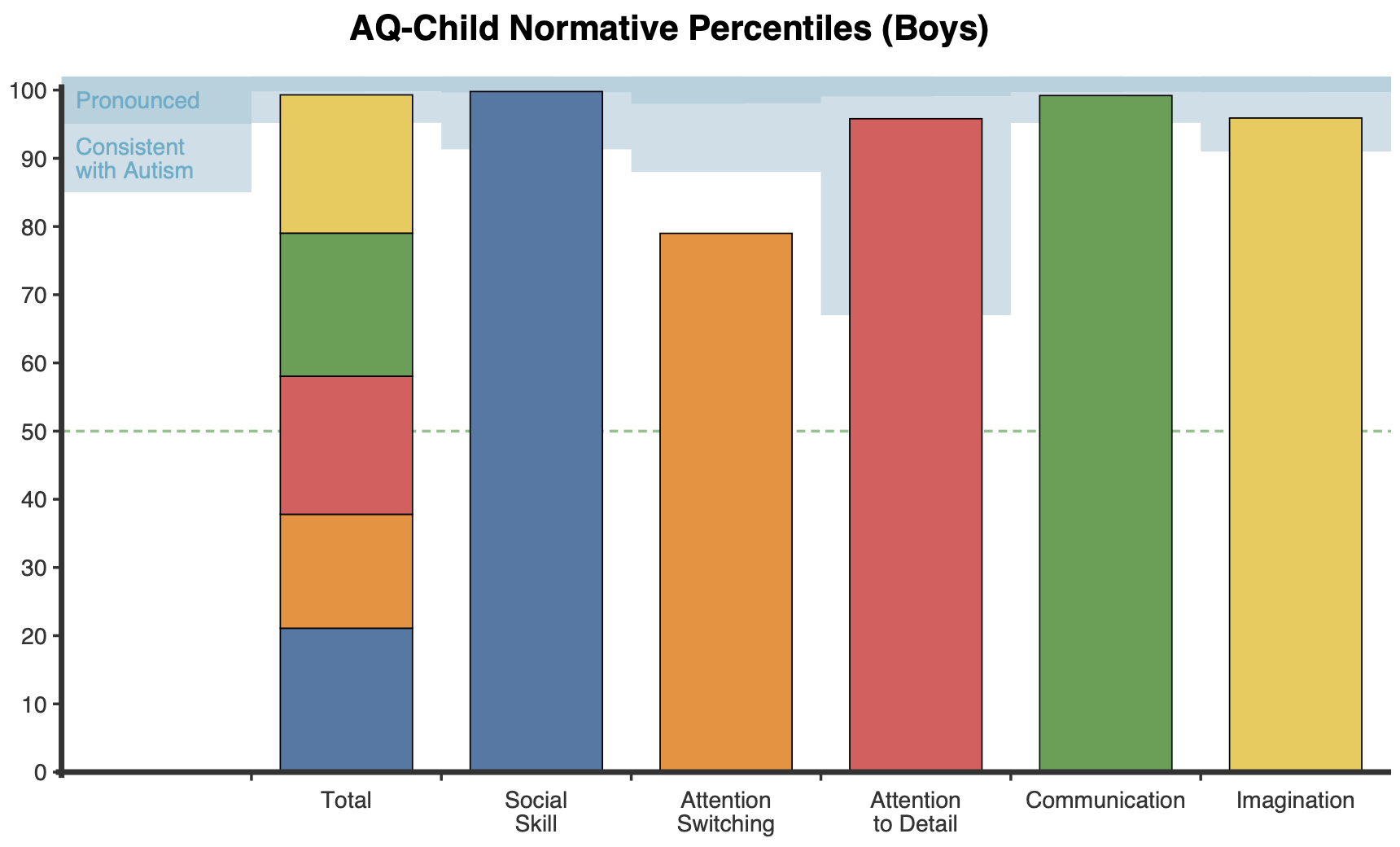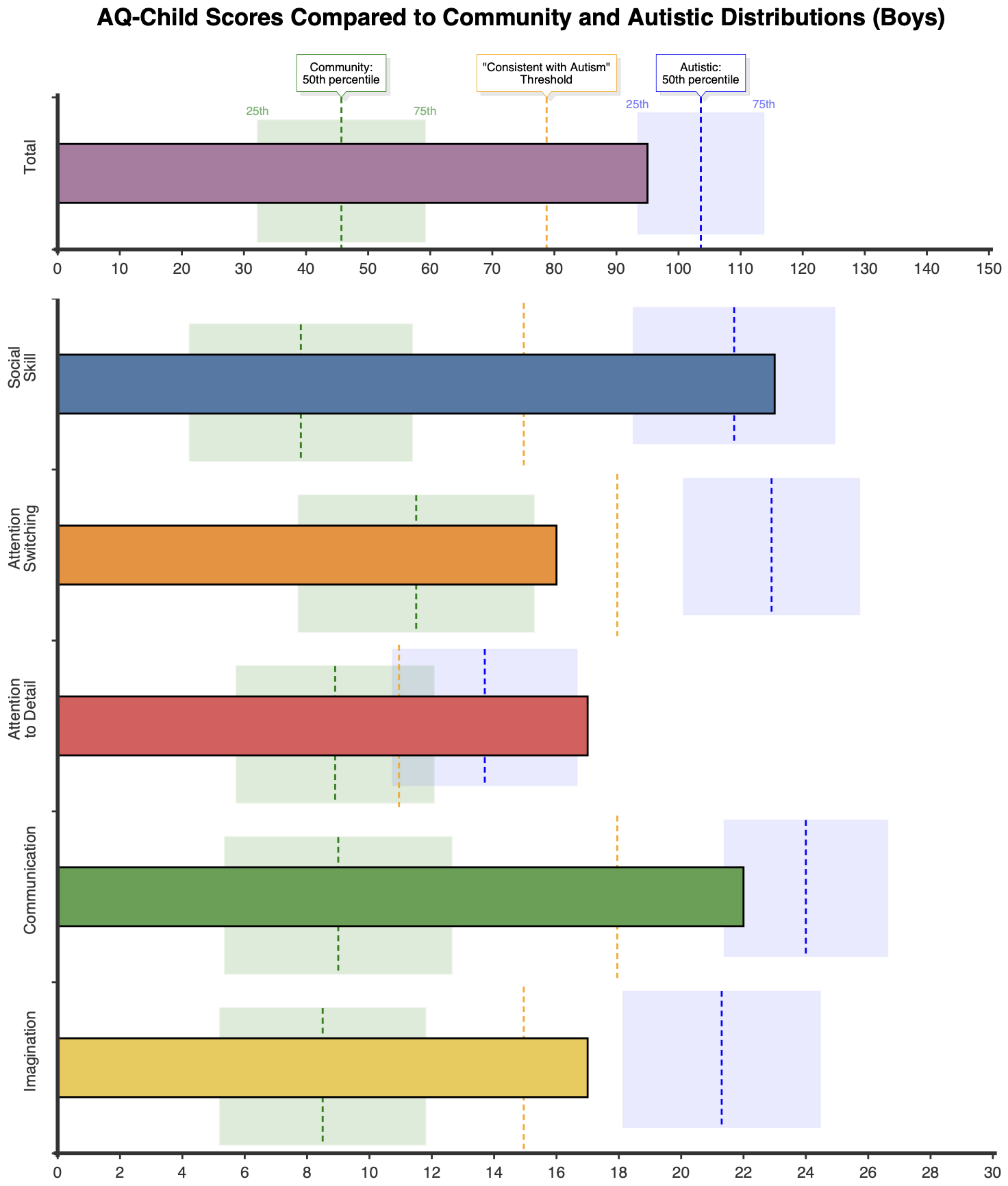The Autism Spectrum Quotient Children’s Version (AQ-Child) is a 50 item parent-report measure that assesses autistic traits in children between the ages of 4 and 11 years.
The Autism Spectrum Quotient Children’s Version (AQ-Child) is a 50 item parent-report measure that assesses autistic traits in children between the ages of 4 and 11 years (Auyeung et al., 2008). The AQ-Child has five subscales, each representing a specific trait relevant for the identification of Autistic children:
The AQ-Child is a widely used parent-report measure of autistic traits. Research indicates that it effectively captures autistic-like trait levels and can help differentiate between Autistic and Non-Autistic children.
While the AQ-Child provides valuable insights into autistic traits and can be used by qualified professionals, such as psychologists, as one part of a comprehensive assessment process for Autism, scores may also reflect phenomena other than, or co-occurring with, Autism. It is important to interpret the results within the context of the child’s developmental history and other personal characteristics.
Autism Spectrum Quotient Children’s Version (AQ-Child) scores are presented as a total scale score as well as scores on five subscales. Higher total scale scores are indicative of higher overall levels of autistic traits. A higher subscale score is indicative of a higher level of the specific trait that is associated with Autism.

The child’s total and subscale scores are expressed as (gender-specific) percentiles based on normative data for children in the general population (Auyeung et al., 2008). The percentiles contextualise the child’s scores relative to the typical scores of children in the general population. For example, the 50th percentile represents the typical levels of autistic traits among children in the general population, while scores on the 90th percentile fall within the top 10% when compared to children in the general population. Scores in this higher range are more consistent with those of Autistic children than children in the general population. For the total AQ-Child score, 5% of boys and 4% of girls score in the range that aligns with the typical scores of Autistic boys and girls, respectively.

A score is classified as “Consistent with Autism” if it more closely resembles the scores of Autistic children than those of children in the general population. To this end, the “Consistent with Autism” thresholds are calculated as the weighted midpoint between the distribution of scores among the Autistic and Community samples (Jacobson & Truax, 1991).
A score is considered “Pronounced” if it is in the upper half of the Autistic distribution, reflecting higher levels of autistic traits. As such, the “Pronounced” thresholds represent scores on or above the 50th percentile when compared to Autistic children.
For the Attention to Detail subscale, a higher “Pronounced” threshold reflecting scores on or above the 90th percentile within the Autistic sample was chosen due to significant overlap between the score distributions of the Autistic and Community samples.
Scores classified as either “Consistent with Autism” or “Pronounced” suggest that the child exhibits autistic traits at a level consistent with Autistic children. Gender-specific distributions of scores, and their classifications, among Autistic children and children in the general population are presented in NovoPsych’s review of the AQ-Child (Baker et al., 2025).
The thresholds for the total AQ-Child score are as follows.
Graphs comparing the total and subscale scores to the normative distribution of scores among Autistic children and children in the general population are presented, with shaded areas corresponding to scores between the 25th and 75th percentile. These graphs contextualise the child’s scores relative to typical levels of autistic traits among Autistic children and children in the general population.

The Autism Spectrum Quotient Children’s Version (AQ-Child) comprises 50 items, with 10 items for each of five theoretically derived subscales representing specific trait dimensions associated with Autism (Auyeung et al., 2008). The AQ-Child was adapted from the adult and adolescent versions of the AQ (Baron-Cohen et al., 2001, 2006). Specifically, the items were rewritten to identify autistic traits through parent-report (as opposed to self-report) and to be relevant for children.
The AQ-Child was validated in Autistic children and children drawn from the general population (Auyeung et al., 2008). This study found that the total scale has high internal consistency (Cronbach’s alpha = 0.97), the five subscale scores have acceptable internal consistency, with Cronbach’s alpha values between 0.83 and 0.93, and that the total score has good test-retest reliability over a 12-week interval (r = 0.85).
Auyeung and colleagues (2008) suggested that a total scale cut-off score of 76 and above could be used to distinguish between Autistic and Non-Autistic children, regardless of gender. However, in the general population, boys typically score higher than girls. NovoPsych has therefore established gender-specific norms and thresholds, based on data obtained from the study by Auyeung and colleagues (2008), to enhance the interpretability and classification accuracy of AQ-Child scores, as described in NovoPsych’s review of the AQ-Child (Baker et al., 2025).
The child’s scores are converted to gender-specific percentiles, providing useful information about the degree to which they exhibit autistic traits relative to typical levels among Autistic children and children in the general population of the same gender.
Auyeung, B., Baron-Cohen, S., Wheelwright, S., & Allison, C. (2008). The Autism Spectrum Quotient: Children’s Version (AQ-Child). Journal of Autism and Developmental Disorders, 38(7), 1230–1240. https://doi.org/10.1007/s10803-007-0504-z
Auyeung, B., Baron-Cohen, S., Wheelwright, S., & Allison, C. (2008). The Autism Spectrum Quotient: Children’s Version (AQ-Child). Journal of Autism and Developmental Disorders, 38(7), 1230–1240. https://doi.org/10.1007/s10803-007-0504-z
Baker, S., Smyth, C., Bartholomew, E., Buchanan, B., & Hegarty, D. (2025). A Review of the Clinical Utility and Psychometric Properties of the Autism Spectrum Quotient Children’s Version (AQ-Child): Gender-Specific Norms, Percentile Rankings, and Qualitative Descriptors.
Baron-Cohen, S., Hoekstra, R. A., Knickmeyer, R., & Wheelwright, S. (2006). The Autism-Spectrum Quotient (AQ)–adolescent version. Journal of Autism and Developmental Disorders, 36(3), 343–350. https://doi.org/10.1007/s10803-006-0073-6
Baron-Cohen, S., Wheelwright, S., Skinner, R., Martin, J., & Clubley, E. (2001). The Autism-Spectrum Quotient (AQ): Evidence from Asperger syndrome/high-functioning Autism, males and females, scientists and mathematicians. Journal of Autism and Developmental Disorders, 31(1), 5-17. https://doi.org/10.1023/a:1005653411471
Jacobson, N. S., & Truax, P. (1991). Clinical significance: A statistical approach to defining meaningful change in psychotherapy research. Journal of Consulting and Clinical Psychology, 59(1), 12-19. https://doi.org/10.1037//0022-006x.59.1.12
NovoPsych’s mission is to help mental health services use psychometric science to improve client outcomes.
© 2023 Copyright – NovoPsych – All rights reserved